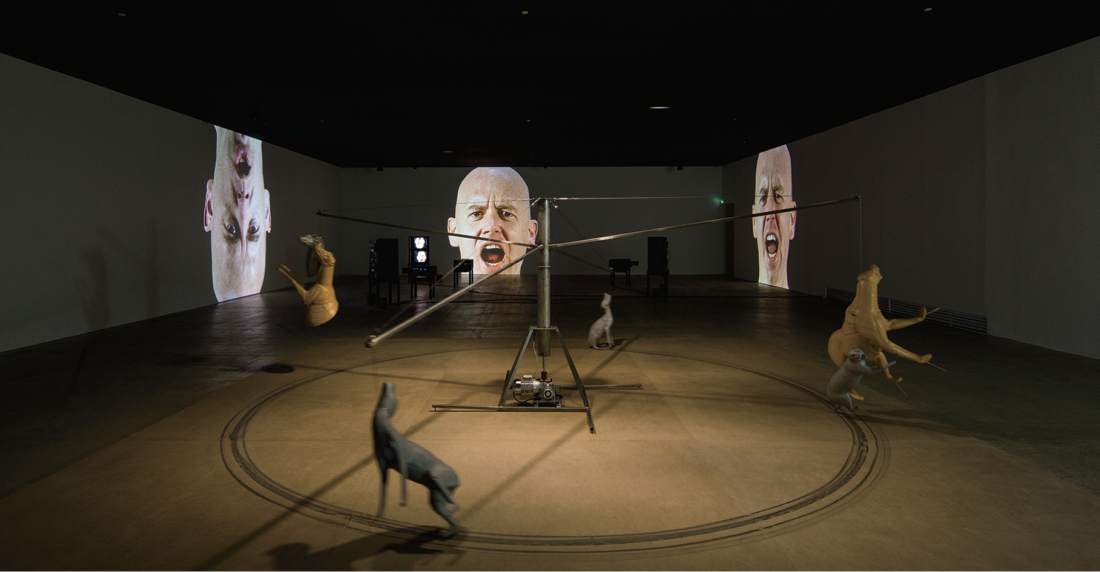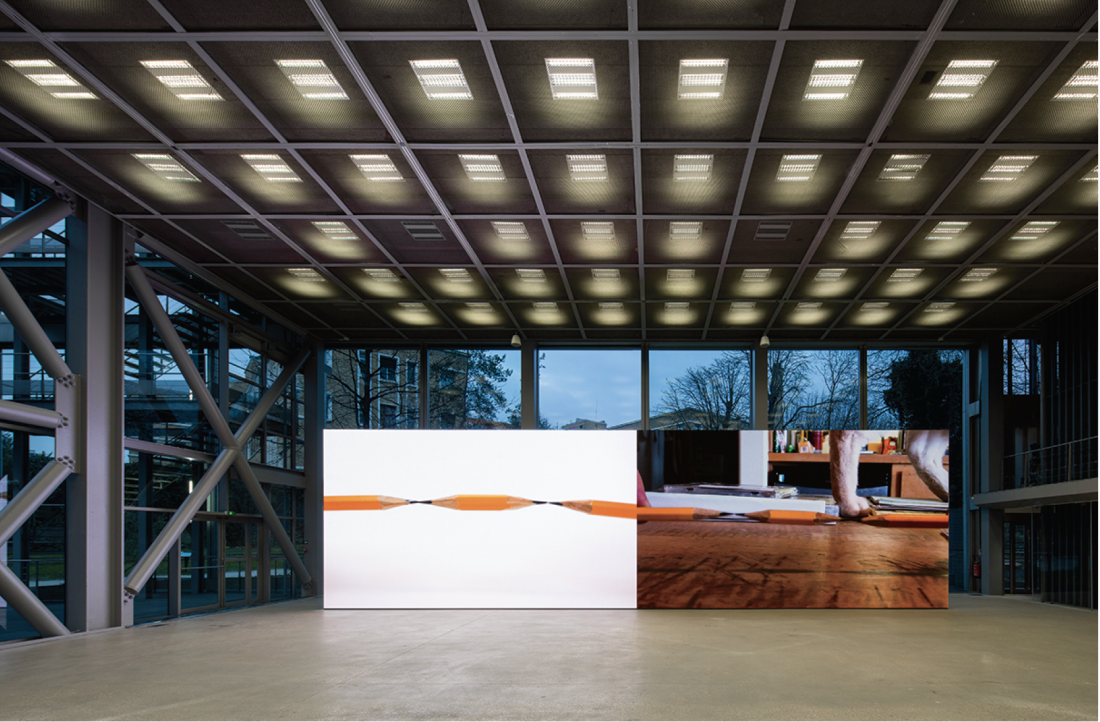Bruce Nauman
Bruce Nauman is one of the most visible, influential and appreciated contemporary American artists. His career began in the ’60s and immediately drew from the key artistic currents of the time: minimalism and conceptual art. The current Fondation Cartier exhibition, “Bruce Nauman,” is the first ambitious showing of his work in Paris for some time. This exhibition is doubly remarkable for an astute integration with its setting, a variously reflective and transparent building, along with a unique garden environment. Its patron, the Societé Cartier, the luxury watchmaker, has long been known for the precision of its time-keeping devices.
The Fondation Cartier resides in a glass building with a surround of trees, grasses, plants and bushes, and this ensemble is situated in the arrondissement of Montparnasse, a neighbourhood favoured by post-war artists and writers. The building by French architect Jean Nouvel, and the garden designed by German artist Lothar Baumgarten were created together in the mid-’90s. Like many German artists of his generation, Baumgarten was briefly a student of Joseph Beuys and this may be the inspiration for his distinctly botanical and anthropological orientation. That is, he is concerned with art considered to be a study of human beings, something scientific sounding. Nauman takes up rigour as a question for artistic practice. At times we might even wonder if some of his early works are actually a parody of rigour and its concern with exactitude.
There is a popular term for a person skilled in calculation and measure; we call this person “a sharp pencil,” meaning rigorous in the analytic sense. Nauman is one such sharp pencil but on another ground, measure as evidenced in musicality, poetry, the cyclical time of nature and the unpredictability that is given with mortality.

Bruce Nauman, installation view, 2015, Fondation Cartier pour l’art contemporain, Paris. Photos: Luc Boegly. Images courtesy Fondation Cartier pour l’art contemporain.
Pencil Lift/Mr. Rogers, 2013, the first work encountered as you enter the building, presents a pair of video images filling an enormous screen with a tightly focused and looped game being played with pencils. Two sharp pencils attempt to suspend a third pencil, sharpened at both ends, between their points. And what could be more compelling than watching the tension implied as you pay close attention to a simple game that rests on the goal of keeping something up, keeping something going for as long as possible, always knowing that it must falter. It’s compelling and establishes a psychical relationship between the viewer and the visible. Suspension is what keeps us in a “between,” that is, perpetually in anxiety. This is a work that brings cinematic perception home.
Descending to the lower level of the building we encounter two works, Anthro/Socio (Rinde Facing Camera), 1991, and Carousel (Stainless Steel Version), 1988. The descent downwards is to an environment that feels “unto itself” and ensures an appropriate entry into the space of these two works belonging to Nauman’s darker side. There is sound in the room, a lot of it, a high volume, layered, repetitive but musical chant occupies all the space, appearing to emanate from the man whose image we see cinematically repeated several times both in projections and on video monitors. His mouth shapes what we hear. We are filled with the sound. The man looks straight at us. There are various sequences in which this huge and cropped head appears at different moments and the ecstatic chant “feed me, eat me, help me, hurt me, anthropology” resonates throughout. Anthro/Socio is confrontational, a “shock,” but a shock that opens to pleasure, even something ecstatic. Concerning this question of “shock” in Anthro/Socio, British painter Bridget Riley wrote of the kindness in the performer’s face ensuring “that the work is not experienced as either menacing or threatening,” and that his chant is “…rather like a madrigal resounding in the space of a cathedral.”
Encountered in the same room and beside Anthro/Socio, a spinning circular “machine” dangles several brutally chopped animal forms. Parallel to the floor this wheel, possibly a “prayer wheel,” flails along, dragging its animal parts, dog-like, horse-like, cat-like, in obviously cast likenesses but with various amputations or cuts that leave us in a bizarre kind of abattoir.

Bruce Nauman, installation view, 2015, Fondation Cartier pour l’art contemporain, Paris. Photos: Luc Boegly. Images courtesy Fondation Cartier pour l’art contemporain.
If Anthro/Socio (Rinde Facing Camera) and Carousel (Stainless Steel Version) present the darker side of Nauman, it is the inclusion of these pieces in the same exhibition with For Children, and For Beginners (Instructed Piano) that releases a clear perception of where Nauman’s intention lies. Finally, the video performance Untitled, 1970/2009, again shows Nauman’s concern with measure in its musicality. As do Nauman’s other works of choreography for dancers, this piece reveals an affinity for the amazing play, Quad, 1981, by Samuel Beckett, in which four performers walk around in synchrony and diagonally cross each others’ paths without ever touching and within a strictly controlled square space.
In his commentary on Nauman, curator and critic Robert Storr has proposed that we are now in an age of lightweight art resting on commercial strategies, and that Nauman is an exception. Perhaps his extensive popularity raises the question of how a body of work can be critical and popular, since for the critical mindset this popularity must imply some degree of audience manipulation or deception at the hands of a culture industry with its museums, critics and collectors. If Nauman’s art world importance is already well charted, there is the broader question as to what is the good in his work? Is it that it raises the classical question of art’s role in providing guidance for life, and that it responds to this question? This may well be the part of his contribution—creating a critical public for art, as well as the basis for his popularity.
Nauman’s pursuit of measure is a thread through the works presented at the Fondation Cartier. From the cinematic mortality of Pencil Lift to the choreographed steps of Untitled, 1970, to the chanted and enchanted space of Anthro/Socio, and the music lesson practised in the garden that intersects with the study of plant life, For Children/For Beginners—all, taken together provide a sense of Nauman’s lifelong commitment to the question of creativity and its value in our lives. Measure, as argued by Nauman, is not a matter of predictability but on the contrary, consists in the movement that is the span of a life lived. From For Children/For Beginners, to the encounter with the dread, anxiety, fear and joy of mortality that underlies Pencil Lift, Anthro/Socio/Anthropology and Carnival (Stainless Steel Version), Nauman stays focussed on what Robert Storr called “existential issues.” The critical rigour of this artistic work consists in its ability to go on reminding us about beginnings, but in the sense, paradoxically, that there is no beginning, only the certainty of the mortality that keeps us suspended in the middle. ❚
Bruce Nauman was exhibited at Fondation Cartier, Paris, from March 14 to June 21, 2015.
Stephen Horne lives in France and writes on contemporary art.

